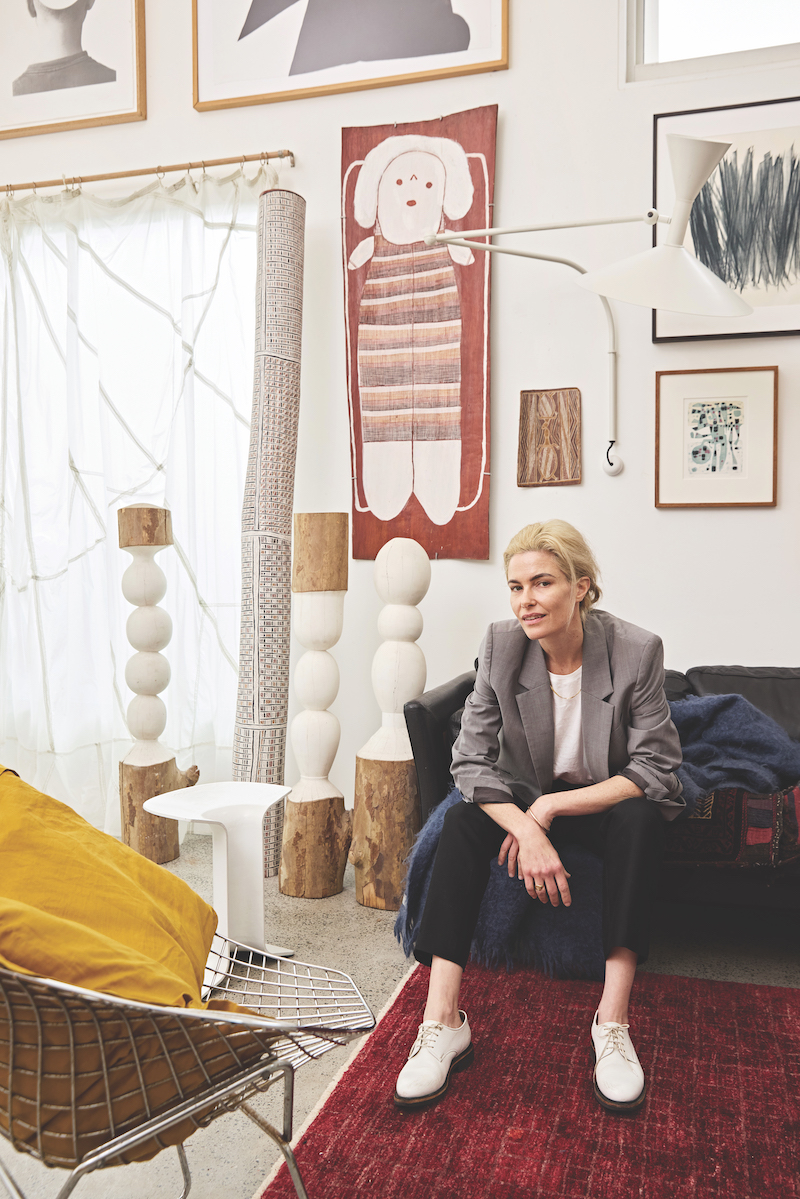Following her graduation from the National Art School in Sydney, Sydney-based Anna-Wili Highfield initially started work as a scenic artist with Opera Australia. Soon after, her career took an unexpected turn when she created a horse sculpture for the window display of a vintage clothing store owned by close friends. Word of mouth and images shared on social media swiftly catapulted her work onto the international stage, bringing with it multiple commissions for luxury brands Tiffany & Co. and Hermès, a story in the New York Times and the cover of Sculpture Review USA.
As a sculptor working with paper and brass, Highfield is now known for creating figurative pieces connected to nature and animals, expertly capturing the abstract yet vibrant forms of native birds and wildlife. With her father a puppeteer and her grandmother a lifelong art lover, it is small wonder that creativity and art have remained a constant in Highfield’s life, and her home and art collection clearly embody this.
Situated on a long block of land she purchased with her mother (who lives in the separate main dwelling), Highfield’s home is a tiny house utilising space in a way that doesn’t make it seem so. Cleverly designed by architect Anna Ciliberto, the house is filled with light as skylights dot the high vaulted ceilings and sliding glass doors expand the interiors to the outside. “It’s absolutely unconventional and really inventive,” Highfield explains. “The more you look at it the more you find.” Hung across the sliding doors are curtains crafted by textile designer Leah Giblin from swathes of vintage parachute material found in Korea, and standing outside like a protective guardian, is a huge sculpture of a horse – scaled up from a brass maquette Highfield made a few years prior. “Everything has a story, and they are all treasures. I often think they are companions in a way.”
Much of Highfield’s art collection has been passed down from family or given as gifts through swaps with other artists, and each piece connects to fond memories and special people. A protruding wall in the main living space designed solely for the purpose of displaying art is home to a rotating selection, including a mid-century bark painting from Arnhem Land gifted by her father and a decorative mask made from turtle shell and woven grass, brought back from Papua New Guinea by her great grandfather in the 1930s. A delicate cloud sculpture by Simon Cavanough hangs near one of Highfield’s own works – a small sculpture of a horse head with a ceramic face hovering above. Overhead is a black and white print from the Wrong Solo series gifted by artist Agatha Gothe-Snape. “These works are like my friends so it’s an added layer when they actually come from real-life friends.”
Pieces from her grandmother’s collection also permeate the living space. Before it came into Highfield’s possession, a lithograph by French artist Alfred Manessier was bequeathed to her grandmother by friends. Despite being in her family collection for some time, it was only recently Highfield discovered who the artist was. “We couldn’t read the artist’s signature. Then in 2019 I was in Paris and walked into a room in the Centre Pompidou. There I saw a painting of virtually the same image, and the artist was finally revealed as mid-century French artist Alfred Manessier.”
First Nations art and culture have been an important part of Highfield’s life as her father’s puppeteering work would take him on tours to remote schools and communities, where he would often stay for long periods of time. A commanding piece in her collection is a vertical bark painting of a Yawkyawk (a Kuninjku/Kunwok word for a female water spirit) by Seymour Wulida, an artist working out of Maningrida Arts & Culture NT. “She is amazing, I love her presence in the house.” Memorial poles by Buku-Larrnggay Mulka Centre artists, Barayuwa Munuŋgurr and Yimula Munungurr, are close by and visually connect with a pair of Mimi Spirits by Eleazer Nangukwirrk, also from Maningrida Arts & Culture.
One of the most personally significant works in Highfield’s collection is a painting by Oliver Watts titled Mother Pelican Feeding Chicks, 2020. Given as a housewarming gift, it represents Highfield and her children, and reflects the origin of her first name – Anna-Wili. “When I was born, my dad was on tour down the south coast in Yuin country. When he called to find out I had been born, there were pelicans circling above the phone booth. He went to the local Yuin community and asked what their name for pelican was. It was Wili.”
Despite being small, Highfield’s home is big on creativity and meaning, and like the dynamic animism of the extraordinary sculptures she creates, art brings her space to life. Describing how it feels to live with her collection as “like the artist has sent an imaginary friend,” Highfield goes on to say, “An artwork can change the energy in a room. They are like spirits. I feel like I am in great company.”
Featured image:Anna-Wili Highfield in her living room. Photos: Nick De Lorenzo. Courtesy: Anna-Wili Highfield.

